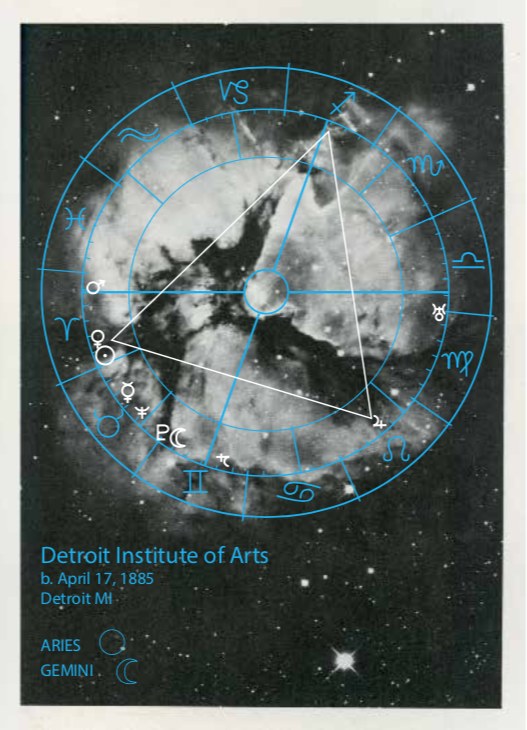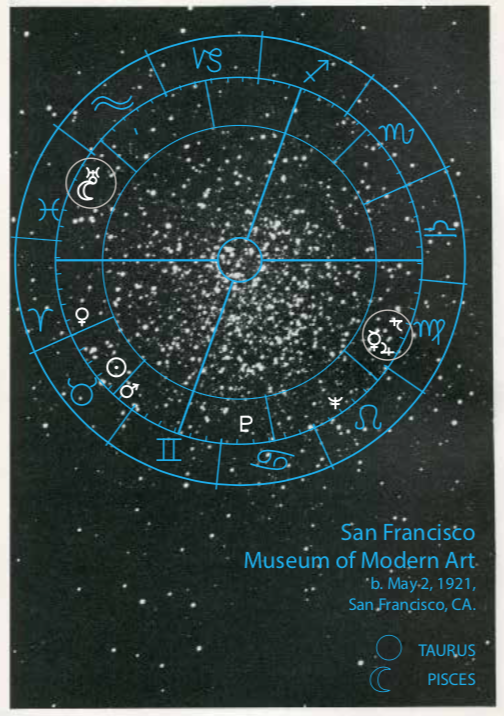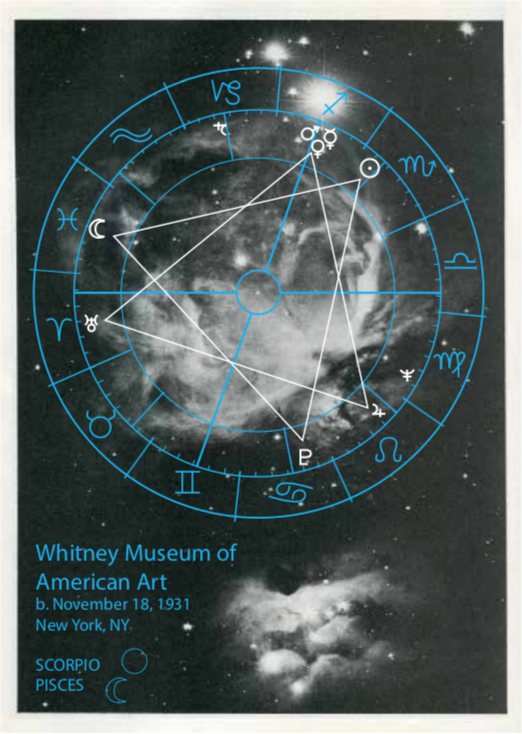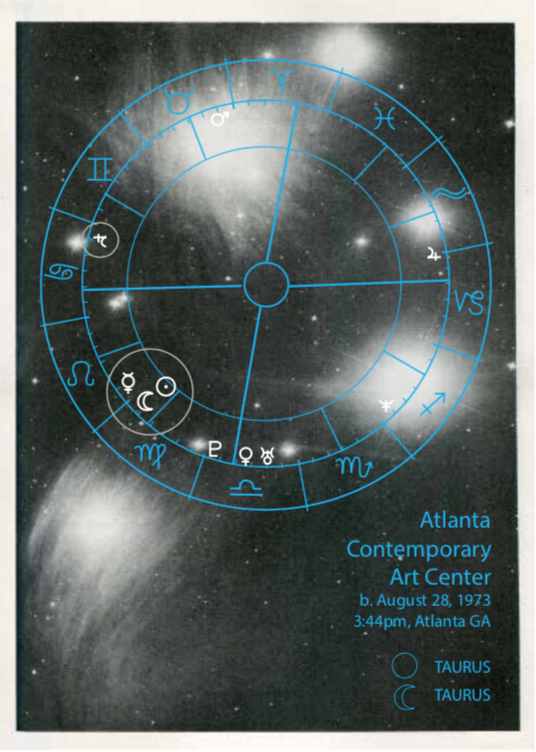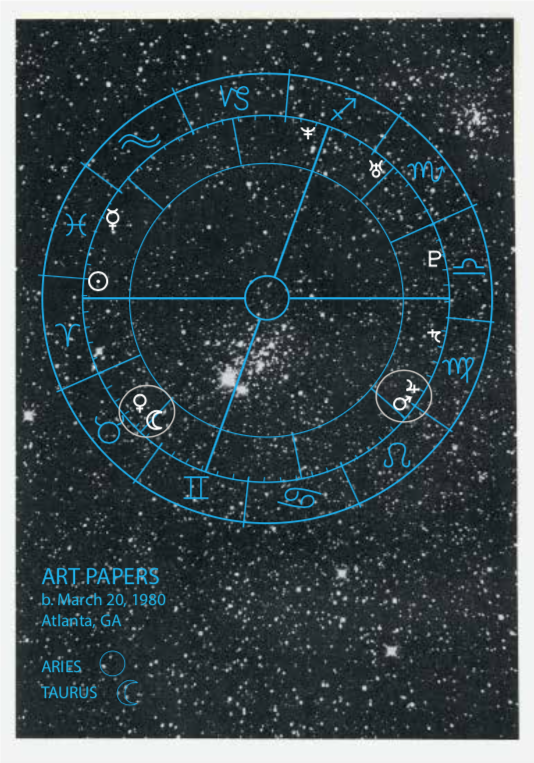Institutional Astrology
“Nebulosity in the Pleiades,” from Robert Burnham, Jr, Burnham’s Celestial Handbook, An Observer’s Guide to the Solar System, Volume Three: Pavo Through Vulpecula (New York: Dover Publications, 1966), p. 1, 877
Share:
Global culture is left brain dominant. We value numbers and all things quantifiable. The Age of Enlightenment gave us confidence through knowledge and logic: we believe in what we can prove, see, and touch. This furthered the way we developed technology and propelled revolutions in industry and communications. We feel highly empowered to control our environment through physical means. Now, we find ourselves in a world that can be quite anti-spiritual. Yet, the Internet Age dawns, garnering new respect for non-material realities. Subcultures continue to push back with “occult” interests, using nature-based signs and symbols to make sense of mysteries that persist.
Astrology is an ancient study of cycles and symbolism. Like artmaking, it is a practice which requires equal parts intuition and analysis. It hails from a right brain world, where the physical cosmos were mysterious, utterly untouchable, and alive with consciousness. Disciplined observers of the night sky found it to be an incredibly accurate clock. Planets, stars, and galaxies kept exact schedules, yet, these early scientists also served as magicians, connecting observations with predictable events and characteristics. They named the heavenly bodies, accepted their wisdom, and praised them as gods. Cross-cultural studies reveal that isolated communities shared the same meanings, imagery and names for constellations (like Taurus the bull or Scorpio the scorpion/dragon). What collective intelligence was being tapped? It seems foolish to entirely dismiss this knowledge.
Sometimes I think astrology works simply because so many people believed in it over such a long period of time. Or perhaps there is something physically magnetic as well as psychological at play when one tunes into the rhythm of the cosmos. I do not understand the mechanism, but to look at a person’s star chart–the traditional map of planet positions at the exact time and place of birth–is to see deeply into an individual’s motivations, talents and tendencies. I have certainly found it to be uncanny as well as informative.
Detroit Institute of Arts
https://www.dia.org/
Out of the 19th century hinterlands of middle America, the Detroit Institute of Arts blasted into being with high energy, excitement, and expectations. The founders had visions of European castles dripping with jewels, endless hallways of gold frames, and annals of descriptive paragraphs sure to be written in significant art history tomes. Industrial capitalists lived in Detroit’s Gilded Age; they were fat and ready to enter the world stage through the arts. In this chart, Sun and Venus are conjoined in late Aries, and in a copacetic relationship with Jupiter in dramatic Leo. This spicy triangular alliance creates an easy, forward-minded flow between savvy business, racy aesthetics, and the need for attention. Fueling this threesome (air feeds fire. . .) is the Moon and Pluto conjoined in the light, friendly trickster, Gemini. Social and intellectual aspirations were deep motivators here. Pluto contributes a grave seriousness to this desire, yet in Gemini it’s played like a dazzling party starlet. Chiron, “the wounded healer,” is also in close degree, adding vulnerability and the talent to teach. This original vibe is hard to imagine, seeing Detroit as it is in the 21st century, equally fired up to perform, though with a more grungy kind of celebrity. Don’t worry, the tragedy may just be part of the high stakes drama. Keep in mind recent news: an appraisal of the institute’s collection commissioned by city creditors estimates its worth at $8.5 billion dollars.
*Time of birth is uncertain, moon degree is therefore also uncertain.
**Because time of birth is uncertain, this birthchart is set generically with a rising of Aries, the first sign.
***Background image: “Trifid Nebula in Sagittarius,” from Robert Burnham, Jr, Burnham’s Celestial Handbook, An Observer’s Guide to the Solar System, Volume Three: Pavo Through Vulpecula (New York: Dover Publications, 1966), p. 1,593
San Francisco Museum of Modern Art
https://www.sfmoma.org/
This institution is quite Earth-bound. Sun, Mercury & Mars are in bullish Taurus. Jupiter (abundance and good luck) and Saturn (matter, discipline and authority) are mixed tightly together in Virgo. These five planets in Earth work rigorously to make real things happen. Taurus likes quantity as well as quality, and so the collection can grow to be significant in size and lavishness. Virgo has the numbers to back it all up. Shifting into video or web, however, may prove distasteful, or unwise for this institution, whose base nature is to play in the touchable, physical plane. A significant conjunction exists between Moon and Uranus in Pisces, which lifts the levels of desire and emotionality to a cosmic scale. Dreams are brilliant, but also unpredictable, unreasonable and unstable. Things wax and wane in choppy cycles, a fateful dynamic which provides a humorous challenge to the bureaucrats at basecamp. In fact, this nodule of Pisces is undergoing a major transit: in July 2014, Neptune passes right over this area of SFMoMA’s chart. Neptune is associated with all things watery and elusive. The Blue Planet recently entered native Pisces (2011-2025) where it is most at home. The last time Neptune was here–164 years ago (1847-1861)–we had the Spiritualist movement, the California Gold Rush, and a civil war. Here and now, it washes, dissolves, and ultimately renews. Although when it’s finally done, all that earthly gain which this institution worked so hard for, may just slide out to sea.
*Time of birth is uncertain, moon degree is therefore also uncertain.
**Because time of birth is uncertain, this birthchart is set generically with a rising of Aries, the first sign.
***Background image: “Globular star cluster NGC 5897, 1.7 degrees SE of Libra,” from Robert Burnham, Jr, Burnham’s Celestial Handbook, An Observer’s Guide to the Solar System, Volume Two: Chamaeleon Through Orion (New York: Dover Publications, 1966), p. 1,109
Whitney Museum of American Art
https://whitney.org/
Wow, this is a place with some incredibly cosmic bones. This institution is blessed with not one, but two strong trines, which are generally quite auspicious. Sun, Moon, and Pluto flow in a triage of water. The Whitney can foster big thinking, dynamic family alliances, heartful yet conceptually stout content, and an overall interest in intensity and passion. Careful: those with Scorpio Sun play cards close to the chest. If threatened, the beast stings. There’s no shortage of emotional sensitivity, which is good for art and perhaps not so good for business. To add to the moody haze, is a layer of artistic fire. Venus (beauty), Mars (energy and assertiveness) and Mercury (communications) are in brave and sometimes careless Sagittarius. Jupiter is in Leo, Uranus is in Aries. The institution is at its best when taking risks and moving heedlessly into the unknown. When it acts radically, it usually prevails. To slow down or conserve is a struggle and a chore. In the past, time was spent building a sound base and powerful alliances. No need to fear making bold moves. However certain new challenges are close at hand. Saturn fast approaches the native’s Scorpio Sun. There is a need to consider new structures or reaffirm old ones. Either way, the cracks are growing wider. Limitations are sure to humble this misty- eyed dragon. At the same time, Pluto exacerbates the wounds, bringing death to aspects which no longer serve the institution and rebirth to take its place. It should be a dynamic few years ahead.
*Time of birth is uncertain, moon degree is therefore also uncertain.
**Because time of birth is uncertain, this birthchart is set generically with a rising of Aries, the first sign.
***Background image: “Great Nebula in Orion M42,” from Robert Burnham, Jr, Burnham’s Celestial Handbook, An Observer’s Guide to the Solar System, Volume Three: Pavo Through Vulpecula (New York: Dover Publications, 1966), p. 1, 316
Atlanta Contemporary Art Center
https://atlantacontemporary.org/
This institution has Sun, Moon and Mercury in the second house of personal resources, meaning its heart and soul is focused on the money. These planets are in Virgo, most flexible Earth sign, who makes dreams come true through practical organization (and counting every bean!). Of course, this also takes some of the fun out of the free flow of artistic endeavors. To balance this, the rising is in late Cancer, with Saturn in the same sign. Cancer is sensitive, devoted to family, sturdy, with that famous protective shell. This is the proverbial sign of slow and steady wins the race. There’s a tendency here to scurry sideways instead of moving directly toward goals. And with Mars in Taurus in the 10th house of career, goals will be achieved tenaciously, albeit at a snail’s pace. Saturn stands hauntingly in the 12th house (in Cancer). I say hauntingly because the 12th house symbolizes the unconscious mind, dreams, undoings, all things hidden, secret and invisible. So something in the back closet seeks to disrupt the stronghold of order inherent here. Karmic duty to family lurks; the flip side, of course is the inherented talents and experience gifted from the ancestors. An open channel to these invisible constituents must be kept alive in order to keep the peace. Aesthetically, Venus is conjoined with Uranus in diplomatic, beauty- driven Libra, falling in the 4th house of property matters: ACAC’s fantasy is to work with a starchitect to design a radical new building.
*This institution is now known as simply Atlanta Contemporary
**Background image: “Nebulosity in the Pleiades,” from Robert Burnham, Jr, Burnham’s Celestial Handbook, An Observer’s Guide to the Solar System, Volume Three: Pavo Through Vulpecula (New York: Dover Publications, 1966), p. 1, 877
ART PAPERS
https://www.artpapers.org/
Early Aries sun makes this institution quite ambitious! But being (relatively) young and full of fire, it might make the mistake of charging out into battle without being fully prepared, or with naive expectations. It will take a few wars to gain the maturity of a samurai. Excellent at business, with a character that is both positive and brave, this institution heedlessly pushes forward. Neptune in adventurous Sagittarius only aids the mission with fiery, far-reaching dreams of success. Luckily, counteracting this native fire is a strong earth element. Venus (representing the arts, beauty, and love) and the Moon (representing underlying motivation, emotions and desire), are “conjoined” in Taurus. This means the two are fused together, adding power to their influence. So, both aesthetically and as a physical object, the magazine wants to be sensual, and materialistic. There’s more earthiness still with Saturn and Jupiter (conjoined with Mars) in disciplined Virgo. Saturn can sometimes be dry, humorless, requiring structure, strict respect for authority, and endless hard work. But Virgo is more than willing to attend to all the details necessary to make it happen. As a communicator (Mercury in watery pisces) ART PAPERS is confident and vast. The one thing absolutely missing here is the element of air, which perhaps can lead to imbalances one way or another regarding the magazine’s intellectual identity.
*Time of birth is uncertain, moon degree is therefore also uncertain.
**Because time of birth is uncertain, this birthchart is set generically with a rising of Aries, the first sign.
***Background image: “Star Cluster NGC 457 / Cassiopeia,” from Robert Burnham, Jr, Burnham’s Celestial Handbook, An Observer’s Guide to the Solar System, Volume One: Andromeda Through Cetus (New York: Dover Publications, 1966), p. 531
Karen Tauches is a designer, curator, and artist based out of Atlanta who also studies astrology.
